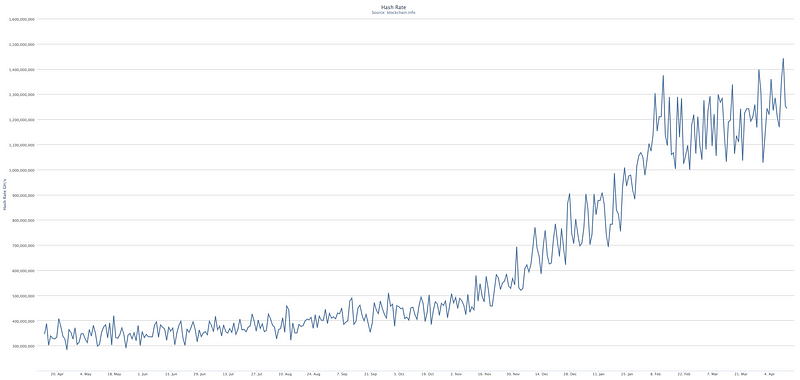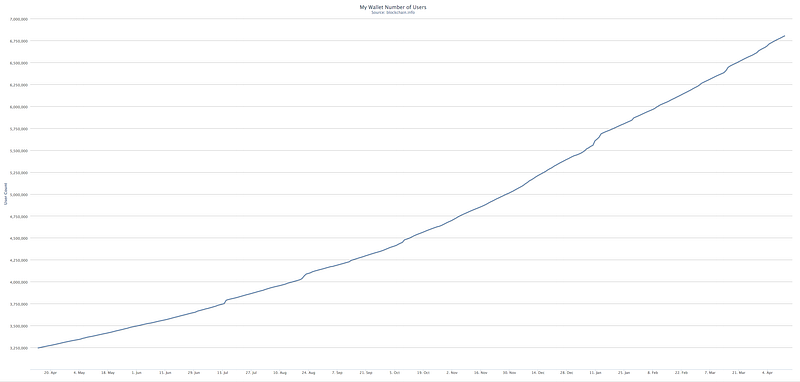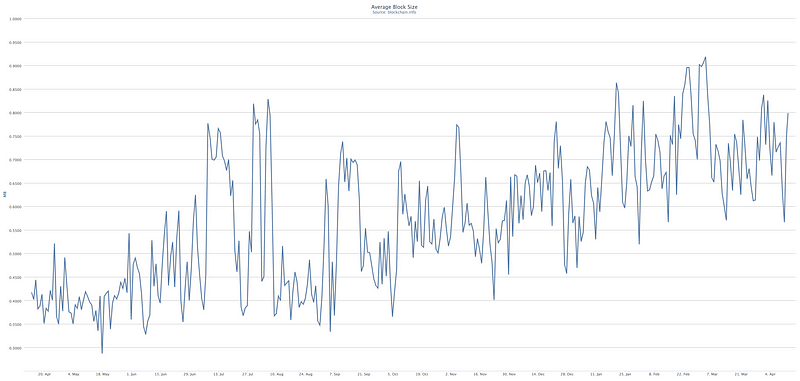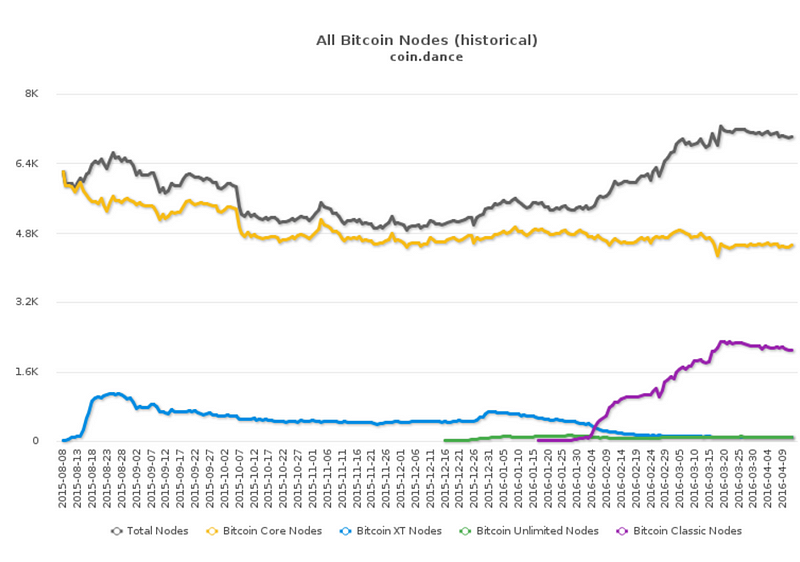
Bitcoin/Blockchain Industry SWOT Analysis
By Frank Schuil
Developments in our industry take place at a rapid pace. To help you make sense of this complicated landscape I applied a simple SWOT analysis to our industry. If you have any questions or comments after reading this do feel free to ping me or comment below.
Strengths
The Bitcoin market has come a long way since its turbulent but meteoric rise in 2013 where it peaked at $266 in Q2 and then hit its all-time highest price of $1242 in Q4 before making its descent to the $400 range where it has been ever since. The Bitcoin Volatility Index depicts the downward trend that should inspire confidence in Bitcoin as a currency.

While the price has stabilised, the network security continues to improve by professional mining operations across the globe. Currently Bitcoin transactions are secured by a staggering 1.4 billion gigahash per second and this continues to grow at an exponential rate as can been seen below. This makes Bitcoin by far the largest and most secure production blockchain in the world. By comparison, runner-up Ethereum only has 2000 gigahash per second securing Ether transactions.


This market maturity extends to the amount and variety of services that we are seeing developed as well as the overall Bitcoin adoption. On average there are about 200.000 transactions on the Bitcoin blockchain every day and the numbers of wallet users now exceeds 6.75 million users on Blockchain.info alone (see below) where the total users is estimated to be in the excess of 10 million users.


All the data confirms that the overall adoption is growing at an exponential rate and that the future of cryptocurrencies looks bright. However, there are obstacles in Bitcoin’s way threatening its pole position.
Weaknesses
Bitcoin was designed as a digital cash system. As such it has limitations that other cryptocurrencies, so-called altcoins, identified as market opportunities. To read more about the specific limitations that are holding back Bitcoin’s adoption, I refer you to my Medium post Why do you think blockchain has such high approval and Bitcoin does not?, which was based on a question I received on my AmA page on Wiselike.
In light of Bitcoin’s scalability issues (more about that below) the altcoin market took off where the total market capitalisation now sits at $1.34B compared to Bitcoin’s $6.55B capturing 16.96% of the total cryptocurrency market. The growth of the altcoin market was lead by Ethereum, a smart contract platform that uses its cryptocurrency Ether as tokens on their blockchain to enable smart contracts. And although Ether has not been introduced as a cryptocurrency per se, it has the same capabilities as Bitcoin with some different characteristics: a different inflation rate, a different confirmation time per block, an anticipated different security model called Proof-of-Stake and a different governance model to name a few. With Ethereum reaching a $1B market capitalisation in March it became a contender for Bitcoin’s pole position that Bitcoin has maintained since its genesis block was solved in 2009. It therefore begs the question, could an altcoin take over?
Let’s talk about scalability. Anyone who has followed this industry the last year may have heard about a former Bitcoin core developer declaring Bitcoin’s death after joining the blockchain company R3. Some of the industry’s vocal proponents characterised it as a rage quit and although Bitcoin has problems, there is at least some truth to that statement since the network is still functioning as intended. So what is the problem then?
Bitcoin has become too popular. Its blocks that make up the blockchain and that contain the transactions are becoming full. In the image below you can see how the average block size has grown over time and currently averages out at 700 kilobyte where it now frequently reaches its maximum capacity of 1 megabyte. This causes delays on the network and forces users to pay a fee to get their transactions prioritised. This forced fee structure may in turn put users off to flee to altcoins like Ethereum. The recent price surge of Ethers could be an indication that this is already happening. To solve this issue there are different proposals, some more elegant than others.

Heated debates resulted in competing proposals for how to proceed. Mike Hearn, the core developer that quit Bitcoin proposed a block increase with its Bitcoin XT proposal. It never gained sufficient momentum. Another group of developers then proceeded to introduce Bitcoin Classic that gained more support. You can see the protocol battle between the original developers known as Bitcoin Core and Bitcoin Classic developers in real-time onCoin.Dance. Below is a graphic representation of the nodes distribution for the different solutions. Nodes are part of relaying the solved blocks. But more importantly, the adoption of the Classic protocol by miners who actually solve the blocks is only at 5.2%, which is a long way off from the 75% that is required. To clarify, the difficulty in reaching consensus lies in the fact that there are many stakeholders with conflicting interests. The developers that write the code, the miners that adopt the protocol, the infrastructure providers like wallets and exchanges that need to implement changes to support the protocol and the end users that experience its implementation effects. Without going into further detail, Bitcoin’s consensus model is both a weakness in that it is very hard to make any controversial — sometimes needed — changes to the protocol and a strength, as its open and distributed nature makes it resistant to censorship.

Opportunities
Cryptocurrencies are in a great macroeconomic spot. I recently wrote an article that explores its future position in relation to automation of the workforce and wealth inequality: Financial Freedom for the Taking, Who is Here to Claim It? And with the narrative in 2013 being focused on Bitcoin’s nefarious aspects to switch to the blockchain narrative in 2015, we are now experiencing a transition back to cryptocurrencies where we seem to be going full circle. Statements from central banks and regulators serve as catalysts for adoption and we are clearly seeing a shift in attitude from the financial institutions. As a prime example of this Barclays announced that it accepted Bitcoin company Circle last week as a customer. This is after the FCA in the UK granted the company an e-money license, which on itself is a major breakthrough. This marks the first time a tier 1 bank opens accounts for a Bitcoin business.
The other side of the opportunity lies in blockchain technology. Much has been said, little has been done. Most of the projects revolve around experimentations and small scale proof-of-concepts. There is however a world of possibilities when it comes to blockchain technology and we are only scratching the surface of its long term implications on industries, governments and society as a whole. To leave you with some inspiration, here is a comprehensive list of potential use cases for blockchain technologies produced by Ledra Capital. One can imagine each of these representing new business opportunities affecting virtually any industry.
Threats
As far as threats go between Bitcoin and the altcoin market, we see Bitcoin’s resilience in companies emulating the early success of some of the proposed innovations by altcoins. As an example, where Ethereum is creating a dedicated smart contract platform, Bitcoin company Rootstock is attempting to do the same on the Bitcoin blockchain. Where scalability is an issue, Bitcoin company Blockstream proposes sidechain technology to scale Bitcoin’s blockchain. Where instant transactions are impossible, we see the introducion of services like Bitgo Instant taking the clearing risk. Long term it remains to be seen whether the market gravitates towards the security of Bitcoin’s blockchain with these technology solutions or whether altcoins will fill these gaps. So far the network effect favoured Bitcoin, going forward this may change. Regardless Bitcoin will likely continue to serve as a store of value — digital gold if you will -, even if more advanced cryptocurrencies and blockchain use cases move elsewhere. And as we are seeing with the emergency of services like Shapeshift.io, interoperability will be key for any of them to be successful.
To the cryptocurrency market as a whole there are mostly regulatory threats. Just like the Internet is censored in parts of the world, cryptocurrencies will face regulatory pressure there where they threaten local currencies and governments. This is not to say that they can be stopped or controlled, it’s more to say that the interactions between cryptocurrencies and the fiat currencies could be throttled to extent that it renders them useless.
On the positive, the global regulatory landscape views Bitcoin favourably with only four countries outright banning cryptocurrencies. And a parallel economy may remove the reliance on the fiat currency economy altogether if the network growth persists. In Europe specifically the European Commission has already expressed the need to apply AML legislation to cryptocurrency businesses.
As for blockchain, it’s currently on top of the Hype Cycle where too few use cases are going into production. This potentially emulates the early days of the renewable energy sector where significant funding and government grants were spent prematurely. Or it could remind us of the Internet bubble where an abundance in funding lead to businesses that scaled too early, were ahead of what the technology could deliver or had no valid business case at all.
For blockchain this may cause delay for wider implementation and it could hurt those businesses that are requiring growth now, having raised significant sums of funding too early. At the same time we are seeing a booming Fintech sector that is putting pressure on the financial industry to innovate aggressively where blockchain is part of their agenda to turn the tide.
First appeared at his Medium.com





